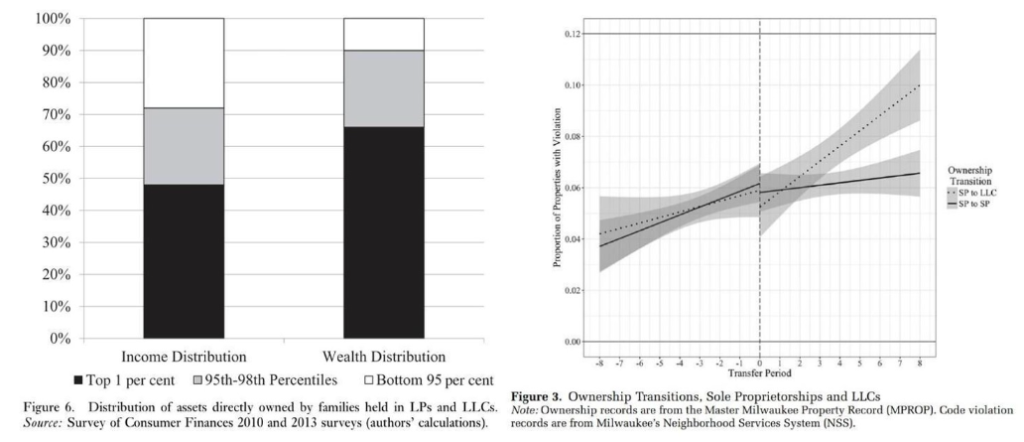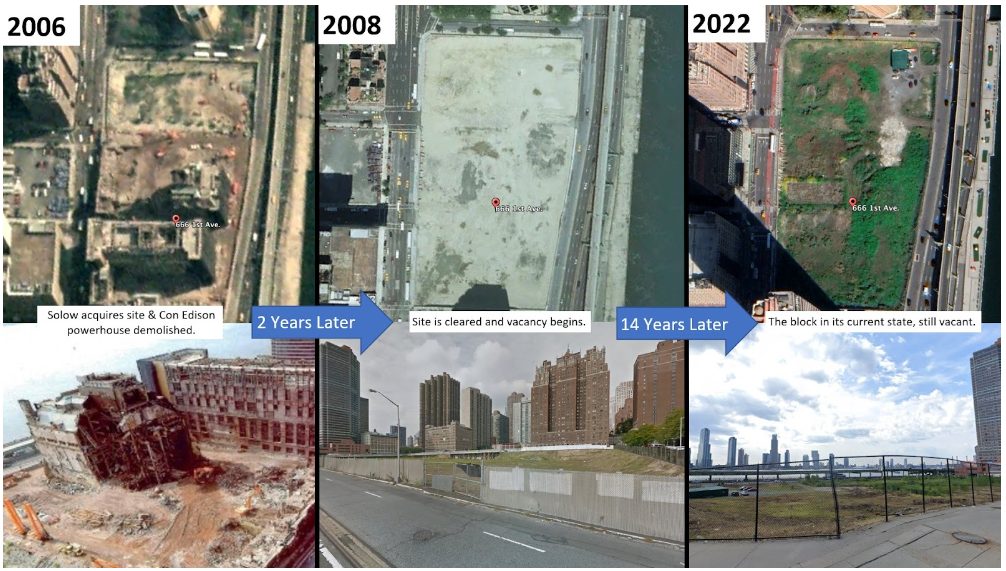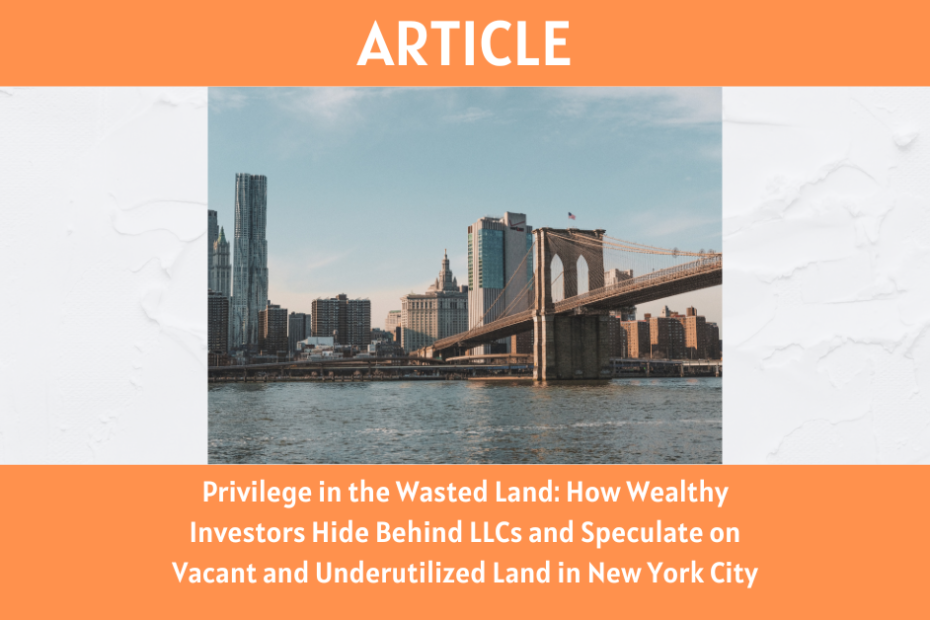Over the past few months, we have published a series of articles which explore the presence of vacant and underutilized land in New York City and the role of Limited Liability Companies (LLCs) in the city’s housing market. Today, we publish our ground-breaking report, Privilege in the Wasted Land, which examines the factors associated with these phenomena and clearly establishes that LLC investors are over-represented among owners of both vacant and underutilized land in NYC.
In the first article in this series, we explored the unique privileges available to real estate investors who utilize the LLC legal structure: anonymity, protection from personal liability, and no corporate taxes (profits are passed-through to the LLC owners). Together, these “Citadels of Privilege” create avenues for tax evasion; prevent tenants from knowing their landlord’s identity, and encourage more ruthless strategies to extract rents, including threats of eviction and under-spending on building maintenance. We found that LLCs play a key role in America’s widening chasm of inequality, squeezing tenants for between one-third and one-half of their income and funneling this revenue into the pockets of LLC owners, who are disproportionately wealthy and white. Our analysis found that LLCs own one in eight properties across NYC, with a combined value of over $100 billion, and found evidence that LLCs are land banking by preferentially buying properties close to subway stops or which have been recently granted additional planning permissions.

Left: Two-thirds of all LLC and LP assets are owned by the top 1 percent (from Soener & Nau, 2019).
Right: Properties acquired by an LLC experience an increase in building code violations (from Travis, 2019)
Our second article examined the phenomenon of land lying vacant even in the midst of thriving urban areas. We found around 18,000 vacant lots in NYC, representing around 4% of land area, and determined that they were more likely to be vacant if they were close to a subway station or had recently been rezoned for development. Henry George identified the reasons for this land banking behavior nearly 150 years ago, when he pointed out that the inherently fixed supply of land at a given location ensures that any improvement in its population, productivity, or popularity will be captured by higher land values. As a result, landowners are able to enjoy unearned increases in the value of their land, regardless of whether they participate in the messy business of building something on top of it. Many owners are therefore happy to leave their land empty, contributing to housing shortfalls, particularly in areas where it is desperately-needed, such as NYC.
Finally, our third article extended the analysis of vacant land to explain how similar speculative dynamics can be at play on sites that remain as a single family home for long periods of time, even while they could profitably be redeveloped into higher-density housing. This is called underutilized land, and it can be just as harmful as wholly vacant land, insofar as it also prevents the creation of much-needed housing supply. We explained that underutilization can formally be defined as a site being used well below its ‘highest and best use’, meaning the maximum of legal permissibility, physical possibility and financial feasibility. However, consensus has yet to be reached on a consistent statistical measure of underutilization, and we proposed one method that would combine redevelopment costs & market rents to identify land that can profitably be redeveloped into more intensive uses. We applied two pre-existing measures and found that, just like wholly vacant land, underutilized land was more common in locations that are attractive to land speculators: in central locations, close to subway stations, and on sites that have recently been rezoned.
In our newly-released report, Privilege in the Wasted Land, we study the intersection between LLC ownership and vacant and/or underutilized land in NYC. What our research has begun to uncover are clear indications that LLC investors are more likely to engage in land speculation, through ownership of vacant and underutilized urban land. Using the City of New York’s MapPLUTO database we have classified 840,000 tax lots in NYC as being LLC-owned, vacant or underutilized. Combining this with spatial information and Census data, we have controlled for a range of physical, demographic and locational variables, and applied a wide range of empirical specifications. We find a clear and consistent pattern demonstrating that LLCs are preferentially purchasing vacant & underutilized land, and likewise that parcels with an LLC landlord are more likely to sit vacant or underutilized.
Simple summary statistics make this relationship clear: while one in eight parcels are owned by an LLC across NYC, this LLC share rises to nearly one in three among vacant parcels, a significant overrepresentation. Likewise, while only 2.2% of all NYC properties are vacant, this proportion is more than doubled among LLC-owned properties, to 4.7%. Similar patterns are observed for underutilized parcels. Regardless of how you slice it, LLCs are overrepresented among owners of vacant and underutilized properties.

To ensure that these observations are not a statistical artifact of some confounding variable, we applied a range of regression techniques to remove the influence of other factors. Our preferred model included control variables for lot area, shape, type and zoning; demographic factors such as neighborhood income, employment, race, SNAP usage and gentrification risk; and locational factors such as centrality (measured by distance to Empire State Building) & proximity to a subway station. Full information about our methodology is provided in our supplementary report, Privilege in the Wasted Land. The table below presents the key results from this analysis, using both a linear probability model (LPM), logistic regression (logit) and a spatial lag model (which helps to account for the fact that vacant land and LLC-owned properties are often highly clustered within a given area):

The above results clearly indicate that LLCs are overrepresented among the owners of vacant and underutilized land, with nearly every single result being strongly statistically significant. We see that if a property is vacant, there is a 9 to 15 percentage point increase in the likelihood that it is owned by an LLC. If a property is underutilized, the likelihood of it being LLC owned rises by around 2 to 3 percentage points. Alternatively, properties which are LLC owned are between 2 and 3 percentage points more likely to be vacant, and 1 to 5 percentage points more likely to be underutilized. Thus, in combination, these results strongly suggest that LLC investors are preferentially buying vacant and underutilized sites. While these results cannot prove a causal relationship between these phenomena, they strongly suggest that LLCs are more likely to engage in land speculation, and may be less likely to develop or redevelop properties under their control.Perhaps the most stunning example of the privilege enjoyed by LLCs in NYC is the infamous piece of land at 666 First Avenue in midtown Manhattan. Totaling over 6 acres, this piece of prime real estate has been bare of buildings since the former Consolidated Edison powerhouse was demolished in 2006. The full history of Google’s Street View depicts an entire city block wasteland, stubbornly lying vacant even while glittering towers spring up around it.

Ownership of this block has been deftly hidden behind multiple layers of LLCs, with the direct owners of the multiple legal lots on the site being called various forms of “First Realty Company LLC,” which are all themselves owned by the East River Realty Company LLC, a company about which very little information is publicly available. It is only because of multiple news articles dating back as far as 2013 that we can tie ownership to the late Sheldon H. Solow. Despite the constant need for more housing to help combat NYC’s expensive rents, and a generous C5-2 zoning that would allow up to 1,500 apartments or 2.5 million square feet of commercial floor space, Solow steadfastly delayed development for more than a decade. In reward for his lack of effort, the size of his estate enjoyed a healthy boost by the value of 666 First Avenue rising from a city valuation of $29 million in 2013, to around $146 million today (see for yourself: Manhattan block 970, lot 1). While most New Yorkers struggle their way through work, producing the many goods and services that keep the city thriving, Solow’s LLC has enjoyed a land value uplift of more than 2,500 times the city’s median income, merely by passively owning land for an entire decade.
So what is to be done about these twin problems, of vacant and underutilized land, and anonymous and neglectful LLC investors. First, it is time to lift the veil on who exactly owns each LLC. Legislation put forward by City Councilman Ben Kallos is a great start, requiring anyone who owns more than 5% of an LLC to disclose their name when filing for a permit of occupancy. Likewise, Assembly member Emily Gallagher and Senator Brad Hoylman have proposed legislation that would assign an identification number to every beneficial owner of an LLC. This information should be combined into a landlord registry, which will enable researchers to better understand who exactly owns the city’s real estate, and will better equip tenants when seeking redress against landlords who have engaged in code violations. Likewise, LLCs should be required to have minimum capitalization requirements and minimum liability insurance, to ensure that tenants have sufficient recourse available when pursuing such torts against neglectful LLC landlords. Finally, if research continues to indicate that LLC landlords engage in more harmful practices towards their tenants (such as by failing to engage in routine maintenance or more harsh eviction practices), there may be a case for further policy interventions to discourage LLC use among property investors.
Next, the city should incentivize vacant and underutilized land to be put to productive use. We have previously advocated for NYC to create a fifth property tax class to capture vacant and underutilized parcels and tax them on their land value, as a mechanism to generate new revenues for the City while simultaneously stimulating their productive reuse. The creation of a fifth class provides clear benefits over the status quo, however, some landowners could still merely choose to do the minimum necessary to return their properties to one of the existing four classes (in which improvement, not land value is emphasized), for example by turning their site into surface car parking. NYC’s Advisory Commission on Property Tax Reform recently made sensible recommendations for improvements to the City’s tax code, such as ending fractional assessments, but remained silent on vacant and underutilized land.
Any subsequent reform efforts should entail strategies for encouraging productive use of the City’s valuable land. For example, the City could consider revisiting its own past practice of exempting new construction and apartment buildings from taxation. Facing an acute housing shortage, 1920s New York enjoyed an explosion of new construction under the policy. Now, 100 years later, it may be time to revisit this notion, this time by shifting all property tax burdens onto land by embracing a land value tax. Because market values already incorporate information about the highest and best use of each piece of land, universal taxation of land values places a relatively greater financial penalty on landowners who are underutilizing their land, creating incentives to redevelop their property. This land value tax could be implemented in a revenue-neutral way by cutting the taxes charged on improvements, giving a tax cut to the many landowners who have already put their site to productive use. Such a shift towards land value taxation would therefore drastically simplify the city’s complicated tax code, while also serving as a de-facto tax on vacancy and underutilization. As our research has shown, this tax would disproportionately fall on the city’s many anonymous LLC investors, ensuring that they contribute their fair share of the city’s revenues, while nudging them into putting NYC’s hotly-demanded land into productive use. Housing costs continue soaring to unaffordable levels in thriving cities nationwide, prompting concerns about speculation by corporate investors.
Our research has shone a light on both phenomena in New York City, and revealed that investors use LLCs to buy vacant & underutilized land, often in locations ripe for speculative gains in land value. Policymakers should act swiftly to improve the transparency of LLCs and ensure that all tenants have recourse against any neglectful LLC landlords. Likewise, as this City contemplates reforms to its property tax code, it should seek to lower tax rates on buildings, replacing the revenues with taxes on vacant & underutilized land in particular, or land value in general.

